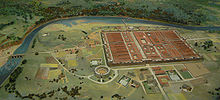
Back كامب ديفا فيكتريكس ARZ Deva Victrix AST Deva Victrix Catalan Deva Victrix Spanish Deva Victrix EU Deva Victrix French Deva Victrix GL Deva Victrix Italian Deva Vitoriosa Portuguese Deva Victrix SH
 A model of Deva at the Grosvenor Museum, rendered as it probably appeared | |
| Location | Chester, Cheshire, England |
|---|---|
| Region | Britannia |
| Coordinates | 53°11′29″N 02°53′34″W / 53.19139°N 2.89278°W |
| Type | Fortification and settlement |
| History | |
| Founded | Mid 70s AD |
| Periods | Roman Imperial |
 |
| Part of a series on the |
| Military of ancient Rome |
|---|
|
|
Deva Victrix, or simply Deva, was a legionary fortress and town in the Roman province of Britannia on the site of the modern city of Chester.[1] The fortress was built by the Legio II Adiutrix in the 70s AD as the Roman army advanced north against the Brigantes, and rebuilt completely over the next few decades by the Legio XX Valeria Victrix. In the early 3rd century the fortress was again rebuilt. The legion probably remained at the fortress until the late 4th or early 5th century, upon which it fell into disuse.
A civilian settlement, or canaba, grew around the fortress. Chester's Roman Amphitheatre, south-east of the fortress, is the largest-known military amphitheatre in Britain. The civilian settlement remained after the Romans departed, eventually becoming the present-day city of Chester. There were peripheral settlements around Roman Deva, including Boughton, the source of the garrison's water supply, and Handbridge, the site of a sandstone quarry and Minerva's Shrine. The shrine is the only in situ, rock-cut Roman shrine in Great Britain.
The fortress contained barracks, granaries, headquarters, military baths, and an unusual elliptical building which had it been finished may have been intended to act as the governor of Britain's headquarters.[2][3]
